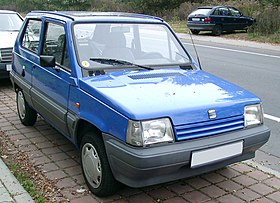SEAT Marbella
| SEAT Panda SEAT Marbella |
|
|---|---|

SEAT Marbella
|
|
| Overview | |
| Manufacturer | SEAT |
| Production | 1980–1986 (Panda) 1986–1998 (Marbella) |
| Assembly |
Pamplona, Spain Barcelona, Spain |
| Body and chassis | |
| Class | City car (A) |
| Body style | 3-door hatchback |
| Related | Fiat Panda Mk1 |
| Dimensions | |
| Wheelbase | 2,160 mm (85 in) |
| Length | 3,475 mm (136.8 in) |
| Width | 1,510 mm (59 in) |
| Height | 1,400 mm (55 in) |
| Chronology | |
| Successor | SEAT Arosa |
The SEAT Panda (codenamed 141A) was a badge-engineered Fiat Panda produced by SEAT from 1980 to 1986, in the company's Landaben plant in the Spanish city of Pamplona (from February 1980 until 29 April 1983, when its production ended in that plant) and also in the Zona Franca plant in Barcelona. After the break in the partnership between SEAT and Fiat, the SEAT Panda model was restyled and renamed. It received a slight restyling in 1983, with a new grille and other slight differences.
The "Marbella" badge was first used for the 1983 model year, on a luxurious version of the SEAT Panda.
After a second, more thorough restyling in December 1986, it received the SEAT Marbella nameplate (codenamed 28 for SEAT Marbella and 028A for SEAT Marbella box) and was produced by SEAT until 1998 in the company's Zona Franca plant in Spain. The end of Marbella production in 1998 also meant the end of vehicle production in that factory. The SEAT model didn't receive the mechanical and cosmetic tweaks (such as the loss of front window quarter-lights) applied to Fiat Pandas "Mark II"s from 1986 but was instead subjected to those from SEAT.
The obvious differences between a Panda and a Marbella are at the front and back of the car where head and tail lights and boot panels are different, the Marbella gaining a pronounced slope to the front panel.
The Marbella featured a boot with capacity of 272 litres, expandable to 1,088 litres when the rear seats are folded.
Mechanically, the Panda borrowed heavily from the Fiat "parts bin", using engines and transmissions from the Fiat 127. The engine is an inline four-cylinder with 40 PS (29 kW) and 903 cc. This proved adequate for this light car which weighed in at about 680 kg. A 60 PS (44 kW) kit to make a more powerful SEAT Panda Abarth version was also on offer, sold in Spain by a company called Apicsa. Shortly after introduction, a smaller-hearted version corresponding to the Italian two-cylinder model was added. Called the "Panda 35", it had a smaller 843 cc version of the engine, a development of the engine originally fitted to the SEAT 850 beginning in the mid-sixties. To set it further apart from the "45", a lower compression rate was chosen. Nonetheless, the smaller engine had to work that much harder to keep up, and in practice the fuel economy savings were negligible.
...
Wikipedia
